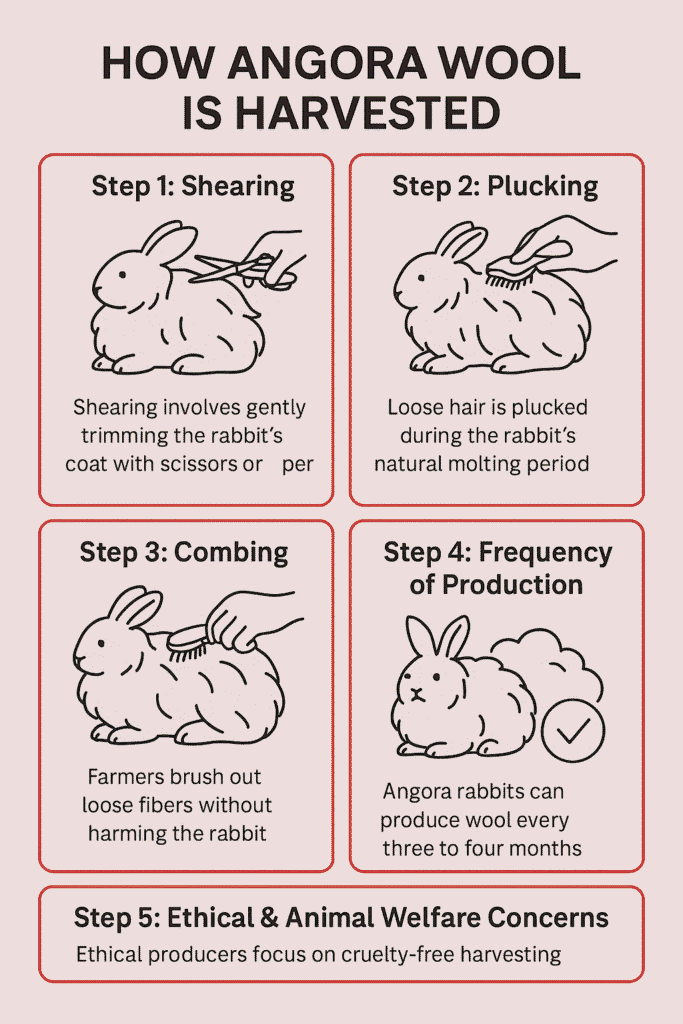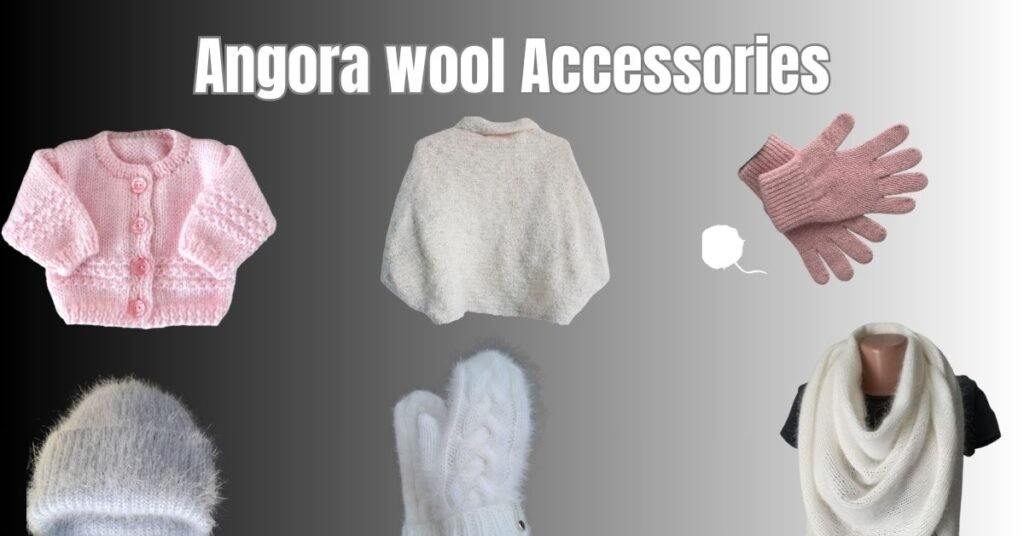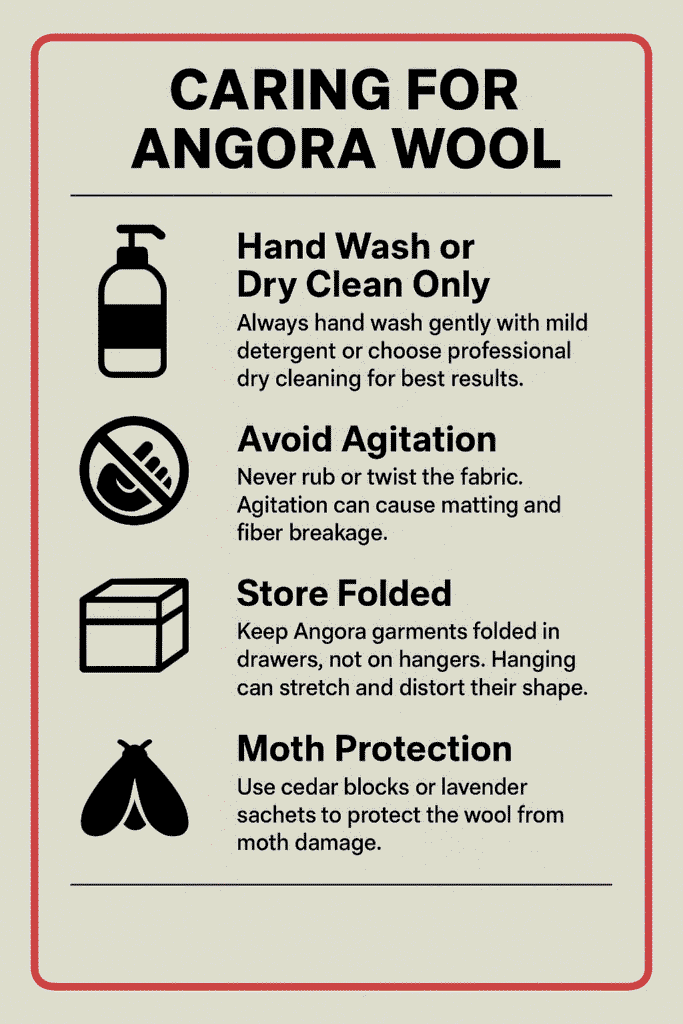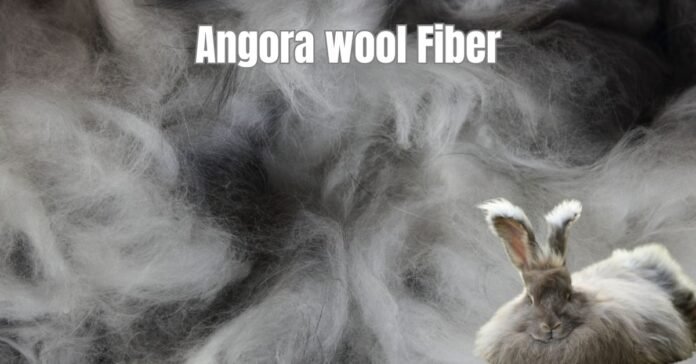Introduction-
The Angora wool is a high end natural fiber that is remarkably soft, fluffy and warm. It is made out of the Angora rabbit which is a breed that is known to have long hair that is silky. Angora wool is sometimes mistaken with mohair (created by Angora goats) or cashmere (created by cashmere goats), but it is the lightness and natural shine of the wool which makes it special.
Due to their fine texture, clothes produced with the use of this kind of fiber are virtually weightless. However, they are very warm and Angora wool is a top winter wear and finer fashion. We should take a look at its origin, its production, and why it is so popular, as well as discussed, across the globe.
Where Does Angora Wool Come From?
Angora Rabbits, Not Goats
Angora wool is made only by the Angora rabbits. These native breeds have been kept centuries as a result of their fine coats. Indeed, human beings started breeding Angora rabbit due to its wooliness as early as 1700s. There are modern breeds of angora: English, French, Satin, German, etc. – each of them is bred to produce plenty of silky fur. True Angora is rabbit hair, and not any goat hair (mohair or cashmere). It has to be well collected through picking up the rabbits.

History of Domestication
The naming of the fiber after the Turkish origin is Angora. Angora rabbits are reported to have started in and around Ankara (previously called Angora) in Turkey, and were introduced to France by 1723. They gained popularity among European nobility during the 18th century and this encouraged breeding programs. By the World War II, the Angora fiber was known globally in terms of softness and silky texture. The current Angora business can be said to have its origins in these pioneer rabbit-farming in Europe and Turkey.
Global Production
The Angora wool that is present in the contemporary world is mostly a product of large-scale farms. Actually, China controls the supply worldwide- about 90 percent of Angora in the world is produced in the Chinese farms. These animals generate thousands of tons of fiber annually. Angora are kept in very small farms in other countries such as France, Hungary, Chile and the United States. Each nation normally produces output so small that China can produce in large volumes, although some artisanal farms raise Angoras in Europe, North America and South America as boutique businesses.
How Angora Wool is Harvested

Shearing
One way of removing Angora wool is shearing. The rabbit is shaved by the farmers using clippers or small scissors, just the same way as shearing sheep. This is most commonly performed on a grooming table: the rabbit is himself held down and trimmed around the head-to-tail, followed by the belly. Shearing removes the majority of fur at once and may produce hundreds of grams of a big rabbit. The coarse guard hairs are mixed with the soft down though, since it cuts through all layers, the wool mix is coarse.
Plucking and Combing
Angora rabbits shed (lose) their fur. In cases where the downy layer is loose then the breeders can pluck or withdraw it by hand. The process is usually performed using a soft comb or at a slow pace by hand. The plucking is commonly done after the rabbit has molting a finished rabbit, and produces nearly pure fine fiber (with little coarse hairs). Unlike shearing, plucking may be tedious and time consuming. (Other breeders brush or groom the rabbit frequently to gather the fiber as it grows off, which is not harmful to the rabbit.)
Harvest Frequency
Angora rabbits have to be harvested several times in a year. An Angora is well-groomed and will grow approximately 3cm of wool every month, thus rabbits are usually sheared or plucked after every 3-4 months. Practically, that means that Angora is collected by the breeders approximately thrice per year. Unless the coat is removed frequently enough, it may overgrow and become matted. Frequent harvesting does not only help to avoid health problems (such as wool block) but also allows the fiber to remain clean and usable.
Ethical & Animal Welfare Concerns
Collection methods are bringing up big welfare concerns. Rabbits can be groomed in small ethical farms. Yet, in the big commercial farms, plucking may be hurtful, especially in the case of large amounts of plucking. Research studies have revealed that rabbits will scream in terror and indirect pain when the plucking is improperly performed. (Rabbits are even more stressed when they are sheared tightly.) Animal activists tell that a good number of practices in the facilities are cruel- small cages and abusive treatment may traumatize these vulnerable creatures. These questions of ethics we discuss further below.
Unique Qualities of Angora Wool
Extreme Softness and Silky Feel
Angora wool is famous in terms of extreme softness. Its fibers are very fine they are 12-16 microns in diameter (cashmere is also comparable). This softness makes Angora even feel like a plush downy cashmere. Indeed, the Angora has been referred to by a number of knitters as being like rubbing a fluffy cloud. The wool has a smooth and silky surface, hence, clothing is comfortable to wear on the skin.
Lightweight Warmth (“Hollow Core” Fibers)
Surprisingly, Angora is quite warm when weighed. The hollow center of each Angora fiber traps air that provides an insulation that is very effective. Due to this arrangement, a layer of Angora will be warmer than a layer of regular wool which is thick. Practically an Angora sweater may be warmer than a corresponding weight of wool sweater. Meanwhile, the air holes render Angora extremely light and lofty.
Natural Fluffiness (“Halo Effect”)
The angora fiber is also characterized by the halo that is referred to as the fuzzy aura of fluff that grows off the surface of the yarn and fabric. When you knit with Angora, you are able to find that the strands of down come off the yarn and form a light halo on the completed work. This makes the Angora knits look like clouds and provide warmth. Colors are also muted and dreamy by the fluffy halo.
Dyeing and Color Vibrancy
Being a protein fiber, Angora absorbs the color just like other animal wools. Practically, jewel-colored and pastel acid dyes have a deep long-lasting color on Angora. Indicatively, several dyers claim that Angora has an easy time absorbing dye and that the colors it develops are very vivid when done with caution. (Acid dyes that work on wool/silk are generally used). Angora is very bright and clear in its color as well, since the base is known to be white of the high grade.
Angora Wool vs. Other Luxury Fibers
| Characteristic | Angora | Cashmere | Mohair | Alpaca |
|---|---|---|---|---|
| Source (Animal) | Angora rabbit wool | Cashmere goat undercoat | Angora goat hair | Alpaca (camelid) fleece |
| Softness | Extremely soft & fuzzy halo | Silky and smooth | Soft, glossy sheen | Soft, but less halo than Angora |
| Warmth | Very high (hollow fiber core) | High | Warm | High (dense fiber) |
| Durability | Delicate; pills & sheds easily | Strong, long-lasting | Very durable & elastic | Durable; retains shape |
| Feel/Texture | Fluffy, cloud-like | Dense, downy | Smooth, lustrous | Warm, sturdy |
Cashmere vs Angora
Angora and cashmere are also ultra-soft luxury fibers, however, each has a different origin and feel. Angora has got rabbit fur; cashmere has got the underpin of cashmere goats. Rabbit fur is usually lighter and more fluffy, and the garments have a halo of the fuzzy appearance, cashmere is dense and smooth. Angoras hollow fibers would be better than cashmere in terms of insulation, being the best in extreme cold, whereas cashmere would be more reliable in changing weather. One of the differences is durability: cashmere tends to be stronger and long-living, whereas Angora is weaker and has a tendency to shedding.
Mohair vs Angora
Angora and mohair are homophones (named after Ankara), but are produced by other animals. Angora is the hair of rabbits and mohair is the wool of Angora goats. Rabbits hair is far lighter and softer; mohair is psychologically smoother, more shiny, and more crisp. The Mohair fibers are more elastic and are very strong, being thicker and more sheen. Angora fibers by contrast are fine, lightweight, and (when untreated) shedding-prone. Mohair replaces Angora in practice where durability, luster are required (such as in upholstery or suits), and Angora is used in delicate warm knitwear.
Angora vs Alpaca
The fibers of angora (rabbit) and alpaca (a camelid) differ a lot. The fibers of alpaca wool are not very fine but rather thick and strong, which provide the fabric with great durability and loft. As a matter of fact, alpaca has been referred to as something hard wearing and easy to maintain. Angora on the other hand is softer and fluffier but weaker. A sweater made of alpaca will be warmer and will last longer in its shape; an Angora sweater will be dustier and will feel like a cloud. Alpaca has a heavier fleece, which is warmer in general, although the hollow fibers of the Angora still make it very warm to its weight. Altogether, alpaca is strong and useful, and Angora is focused on the exquisite softness.
Uses of Angora Wool

Knitwear (Sweaters, Scarves, Hats)
Angora is mostly worn in knitwear. Its halo and softness suit well in the sweaters, cardigans, shawls, scarfs and beanies. It is frequently mixed with other yarns, however, pure Angora knits (or high-angled blends) make some of the most comfortable clothing. Angora sweater, or hat, looks fuzzy and is extremely light and warm. An example is luxury knitwear designers who take the form of using Angora to make a sweater feel like one is wearing a cloud.
Luxury Garments and Accessories
Angora is also used in expensive fashion designs in addition to the basic knits. Designers can apply it on fine wraps, fancy coats, or fancy stoles where its delicateness is a plus. Due to its beauty in the form of drapes and shininess, even a little, Angora is presented in evening devils and opulent accessories. Angora is even used as a fuzzy trim on lingerie and even bridal veils. When any garment is marked as luxury rabbit wool, it is normally referring to Angora.
Blended Fabrics
Pure Angora is susceptible to fragility and thus, it is commonly mixed with other strands. Familiar mixes are Angora, combined with the wool of sheep, silk, a cashmere, or synthetic wool such as nylon. By combining, it gives the yarn strength, elasticity and the ability to maintain its shape. An example is that a sweater yarn may be 50% Angora and 50% merino wool. Business Angora yarn is normally spinned with either wool or nylon so as to be more durable. In this manner, clothes will acquire the Angora fluff and plush without excessively stretching or pilling.
Pros and Cons of Angora Wool
Pros of Angora Wool
- Unsurpassed Softness: Soft to the touch.
- Extraordinary Coziness: Hollow fibers have better insulation.
- Flexible Lightweight: Not to be bulky.
- Embellished Beauty: Gives a full, fluffy halo to the clothes.
- Good Moisture Control: Stays warm but breathable.
Cons of Angora Wool
- Delicate Fiber: This is delicate and needs to be handled and cleaned carefully.
- Shedding Issues: during wear, fibers shedding is easy.
- High Cost: It is costly because of low production.
- Ethical Issues: There are allegations of cruelty in some of the farms.
- Little Life Span: It is not as hardy as cashmere or alpaca.
Sustainability & Ethical Concerns
Issues with Rabbit Welfare
The large-scale Angora farms have been severely criticized with regards to keeping rabbits in small cages where they have little space to move. Lack of proper hygiene, stress and rough handling may severely affect their health and fur quality. These activities leave significant ethical concerns regarding the actual price of luxury fashion.
Animal Cruelty Concerns
Sometimes, ugly videos of rabbits being plucked with harshness have been recorded by animal rights organizations such as PETA, resulting in pains and injuries. With the increased awareness, a number of international brands e.g. H&M and Zara have ceased to use non-ethical Angora in their collections. This trend has led to a call by the industry to the issue of humane sourcing and transparency.
Rise of Ethical & Cruelty-Free Angora
To address these problems, most small farms have resorted to shearing or combing of their animals without causing harm to the animals. Certified cruelties free Angora programs guarantee healthy, clean and stress free rabbits. As consumers support ethical manufacturers, they can indulge themselves in the luxury of Angora and support animal welfare and sustainability.
Caring for Angora Wool

- Gentle Cleaning: Angora should always be hand washed using cold water and mild wool shampoo, or be taken to the dry clean. Keep off heat and bleaching agents.
- Never Wring, Twist, Tumble-Dry Angora: Rather, put up items by squeezing water out and putting them flat to dry. The coarse handling of the cloth will deform the fibers and destroy the cloth.
- Proper Storage: Angora garments should be stored in a folded (not hanging) fashion in order to preserve shape. Store in breathable containers (such as a cotton bag) to avoid moisture. Do not expose them to direct sunlight and heat, which erode fibers.
- Moth Protection: Angora moths like any other animal fiber clothing attract moths. Cedar blocks or lavender sachets are good store pieces to keep in place, and airtight storage bags are to be considered. Wash and dry clothes frequently to keep off insects.
Buying Guide: What to Look For
- Fiber Content: See the label. 100% Angora is highly costly but very soft; blends (e.g. 50% Angora/50% wool) are more affordable and stronger. The more the Angora percentage, the more luxurious the feel, as a rule.
- Its authenticity: touch it: the real Angora is incredibly soft and light. Pull the fibers with some force, they will lose fuzz to a certain extent. Also beware of labels which only state rabbit fur, but not Angora. It is also possible to test a loose fiber (genuine Angora does not smell like plastic, it smells like burned hair).
- Ethical Source: In case of animal welfare, find the brands that indicate clearly that their products are cruelty-free Angora. Ambika Boutique (USA) and Orkney Angora (UK) are some of the well-known ethical manufacturers. These small farms have their own bunnies which they shear and are open about their practices. tags brands to determine whether they offer farm details or certifications.
Conclusion-
Angora wool is indeed a luxurious fiber, which is praised because of the amazing softness, warmth, and beauty. Yet, it has a liability as well, to promote the ethical treatment of animals and help to ensure sustainable practices.
The kinds of things you would have when you wear it responsibly sourced Angora is not only your comfort but also your peace of mind. Angora is still the symbol of elegance and care, and it will be best used in a cruelty-free environment when made with compassion.
Read More>> About what is Mongolian cashmere?
FAQs
This is solely based on the harvesting of the wool. Avoiding cruelty in farms Ethical farms employ mild combing or shearing techniques that do not hurt the rabbits. Always seek labels or certifications that contain the word cruelty free in order to make sure that the wool is so sourced.
The cost of angora wool is high since it is a hand-spun material that takes special attention to the rabbits and grooming. The productivity of rabbits is very low and processing is largely manual. All these are what make Angora a luxury fiber, which is very rare and valuable.
Yep, Angora wool is in most cases warmer than cashmere in that fibers are hollow and therefore capture air to provide the best insulation. Although it is lightweight, it keeps one very warm during cold weather. This is ideal in warm up sweaters and winter accessories.
It is true that the Angora wool is a natural shedding wool, because of its fluffy and light fiber. The Pure Angora clothes are prone to shedding tiny fibers as time goes by, particularly upon rubbing. This shedding can be reduced by blending with wool or nylon and retain the softness.
Angora garments can withstand five years to ten years with proper care and storage. They however, are more fragile compared to cashmere or alpaca and therefore gentle washing and handling is required. They are stored in a folded and moth-guarded condition, to enable them to last longer in beauty.

I really appreciate how you addressed the ethical concerns surrounding Angora wool. It’s great to see that more brands are prioritizing cruelty-free sourcing practices. It gives consumers more confidence in choosing products made from this fiber.